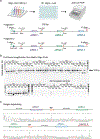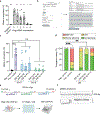Reprogramming the piRNA pathway for multiplexed and transgenerational gene silencing in C. elegans
- PMID: 35115715
- PMCID: PMC9798472
- DOI: 10.1038/s41592-021-01369-z
Reprogramming the piRNA pathway for multiplexed and transgenerational gene silencing in C. elegans
Abstract
Single-guide RNAs can target exogenous CRISPR-Cas proteins to unique DNA locations, enabling genetic tools that are efficient, specific and scalable. Here we show that short synthetic guide Piwi-interacting RNAs (piRNAs) (21-nucleotide sg-piRNAs) expressed from extrachromosomal transgenes can, analogously, reprogram the endogenous piRNA pathway for gene-specific silencing in the hermaphrodite germline, sperm and embryos of Caenorhabditis elegans. piRNA-mediated interference ('piRNAi') is more efficient than RNAi and can be multiplexed, and auxin-mediated degradation of the piRNA-specific Argonaute PRG-1 allows conditional gene silencing. Target-specific silencing results in decreased messenger RNA levels, amplification of secondary small interfering RNAs and repressive chromatin modifications. Short (300 base pairs) piRNAi transgenes amplified from arrayed oligonucleotide pools also induce silencing, potentially making piRNAi highly scalable. We show that piRNAi can induce transgenerational epigenetic silencing of two endogenous genes (him-5 and him-8). Silencing is inherited for four to six generations after target-specific sg-piRNAs are lost, whereas depleting PRG-1 leads to essentially permanent epigenetic silencing.
© 2022. The Author(s), under exclusive licence to Springer Nature America, Inc.
Conflict of interest statement
Competing Interests
The authors declare no competing interests.
Figures














References
Publication types
MeSH terms
Substances
Grants and funding
LinkOut - more resources
Full Text Sources
Molecular Biology Databases
Research Materials

